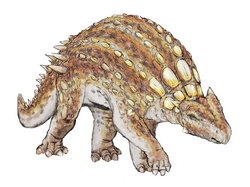Minmi
Minmi is a genus of small ankylosaurian dinosaur that lived during the Lower Cretaceous of Australia, about 119 to 113 million years ago.
| Minmi Temporal range: Lower Cretaceous, 119–113 mya
| |
|---|---|

| |
| Scientific classification | |
| Kingdom: | |
| Class: | |
| Superorder: | |
| Order: | |
| Suborder: | |
| Infraorder: | |
| Genus: | Minmi
|
A recent cladistic analysis suggests that Minmi is the most basal known ankylosaur.[1] That does not mean it was the ancestor of the group; it is far too late for that. It means its body is not specialized, and is relatively unchanged from whatever was the ancestral group.
Two good specimens of Minmi have been described, including a mostly complete skeleton, and additional fragments may belong to this genus. The dinosaur grew to about 2 m (6.5 ft) long (Holtz),[2] or 3 m long and weighed about 300 kilograms (Paul).[3] It was roughly 1 m (3 ft) tall to the top of the shoulder.
Paleobiology
Minmi is classified in the Ankylosauria, but is too 'primitive' (basal) to be included in either the Ankylosauridae or Nodosauridae.
As with other ankylosaurians, Minmi was herbivorous Unlike most herbivorous dinosaurs, there is direct evidence of the diet of Minmi: gut contents are known from the well-preserved nearly complete specimen. The gut contents consist of fragments of fibrous or vascular plant tissue, fruiting bodies, spherical seeds, and tissue (possibly from fern sporangia). The most common remains are the fibrous or vascular fragments, which have clean cut ends.
Because of the small size of the fragments, they are probably nibbled from plants or chopped in the mouth. These small fragments may have come from twigs or stems, but their size is more suggestive of vascular bundles in leaves. The clean cuts, and lack of gastroliths,[4] suggest that the animal relied on chewing to grind food. The seeds (0.3 mm [0.01 in] across) and fruiting bodies (4.5 mm [0.18 in] across) were apparently swallowed whole. When compared to gut contents and scat from modern herbivorous lizard, emu and goose, this shows Minmi had a more sophisticated process for cutting up plant material.[5]
It had bony protrusions on its head, back, abdomen, legs and along the tail. Several types of armour are known in place in Minmi, including small ossicles, small keeled scutes on the body, large scutes without keels on the snout, large keeled scutes on the neck, shoulders, and possibly tail, spike-like scutes on the hips, and a combination of ridged and keeled scutes and triangular plates on the tail. There was one preserved ring of scutes around the neck. The arrangement of armour is unclear on the tail, although the triangular plates may have run on the sides of the tail, with long scutes forming a row along the top of the tail.[6] However, unlike other ankylosaurians, Minmi had horizontal plates of bones that ran along the sides of its vertebrae (hence its species name, M. paravertebra).
References
- ↑ Richard S. Thompson; et al. (2011). "Phylogeny of the ankylosaurian dinosaurs (Ornithischia: Thyreophora)". Journal of Systematic Palaeontology. 10 (2): 301–312. doi:10.1080/14772019.2011.569091. S2CID 86002282.
- ↑ Holtz, Thomas R. Jr. 2008. Dinosaurs: the most complete, up-to-date encyclopedia for dinosaur lovers of all ages. Supplementary Information
- ↑ Paul, G.S., 2010, The Princeton Field Guide to Dinosaurs, Princeton University Press p. 227
- ↑ stones in stomach for grinding food
- ↑ Molnar, Ralph E.; Clifford, H. Trevor (2001). "An ankylosaurian cololite from Queensland, Australia". In Carpenter, Kenneth (ed.). The armored dinosaurs. Bloomington, IN: Indiana University Press. pp. 399–412. ISBN 0-253-33964-2.
- ↑ Molnar, Ralph E. (2001). "Armor of the small ankylosaur Minmi". In Carpenter, Kenneth (ed.). The armored dinosaurs. Bloomington, IN: Indiana University Press. pp. 341–362. ISBN 0-253-33964-2.